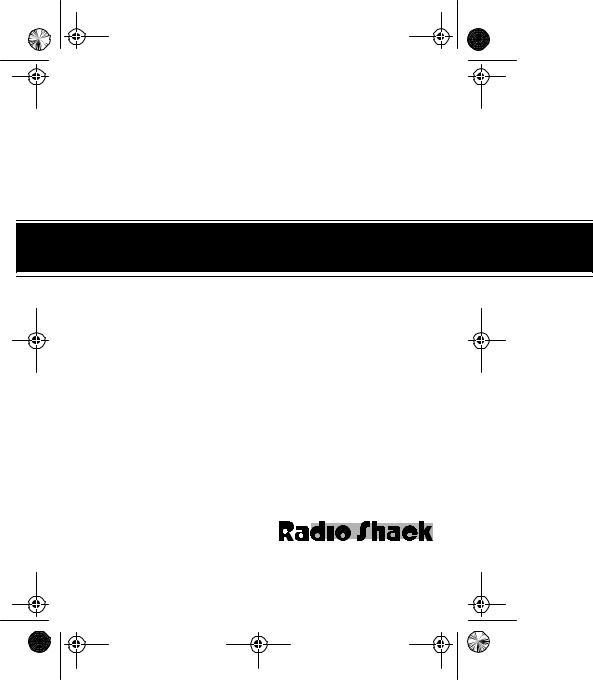Radio Shack TRC-232 User Manual

21-1672.fm Page 1 Thursday, August 5, 1999 12:04 PM
Cat. No. 21-1672
OWNER’S MANUAL
Please read before using this equipment.
TRC-232
4-Watt 40-Channel CB Walkie-Talkie

21-1672.fm Page 2 Thursday, August 5, 1999 12:04 PM
FEATURES
Your Radio Shack TRC-232 4-Watt 40-Channel CB WalkieTalkie is a portable, two-way citizen’s band radio that you can carry almost anywhere. Use it around the house, in your office, or in your car or boat. You can put your walkie-talkie to good use on fishing and camping trips, or you can use it in your business for security patrols, supervisors, or warehouse personnel.
Your walkie-talkie has these advanced features:
Digital Phase-Locked Loop (PLL) Frequency Synthesizer — provides the highest degree of accurate and stable tuning.
Auto-Scan — searches for active channels.
Dual Watch — lets you monitor one channel while listening to another.
Two Power Levels — let you save battery power on short-range transmissions.
Power Saver — reduces power consumption by 30% when the walkie-talkie is not receiving a transmission.
Large, Illuminated, Digital Display — shows the channel number, battery condition, RF power, and incoming signal strength.
Base-Loaded, Helical Antenna with BNC Connector — provides excellent reception and transmission.
©1997 Tandy Corporation. All Rights Reserved.
Radio Shack is a registered trademark used by Tandy Corporation.
2

21-1672.fm Page 3 Thursday, August 5, 1999 12:04 PM
Built-In, Ceramic Filters — ensure superior selectivity and freedom from adjacent-channel interference.
Automatic Modulation Control — ensures a constant RF modulation level.
Automatic Gain Control — maintains a constant volume level, regardless of the signal strength.
Automatic Noise Limiter — helps reduce noise caused by nearby electrical equipment, such as motors or automotive ignition systems.
DC Adapter Cord — lets you operate the walkie-talkie from your vehicle’s cigarette lighter socket or AC power, and connect the walkie-talkie to an external, mounted antenna.
Optional Power Sources — let you operate the walkie-talkie from alkaline batteries, rechargeable nickel-cadmium batteries, your vehicle’s cigarette lighter socket, or AC power.
Note: You can operate a walkie-talkie without an FCC license.
For your records, we recommend you record your walkie-talkie’s serial number in the space provided. The serial number is on the walkie-talkie’s back panel.
Serial Number ________________
3

21-1672.fm Page 4 Thursday, August 5, 1999 12:04 PM
CONTENTS
Preparation ............................................................................ |
6 |
Connecting an Antenna ................................................... |
6 |
Power Sources ................................................................. |
8 |
Using Alkaline Batteries ............................................ |
8 |
Using Rechargeable Batteries ................................ |
10 |
Charging Nickel-Cadmium Batteries ....................... |
12 |
Using Vehicle Battery Power.................................... |
14 |
Using AC Power....................................................... |
16 |
Using an External Speaker ............................................. |
18 |
Connecting an External Speaker/Microphone................. |
19 |
Using the Wrist Strap ...................................................... |
19 |
Using the Belt Clip............................................................ |
19 |
Operation .............................................................................. |
20 |
Receiving Transmissions and Adjusting Squelch ........... |
20 |
Transmitting .................................................................... |
22 |
Using Special Controls and Functions ............................ |
23 |
Turning On/Off the Light .......................................... |
24 |
Using Last Channel Recall....................................... |
24 |
Scanning Incoming Signals...................................... |
25 |
Alternating Between Two Channels ......................... |
25 |
Monitoring Channel 9............................................... |
26 |
Locking the Functions ............................................... |
27 |
Power Saver.................................................................... |
27 |
Operational Hints ................................................................. |
28 |
Common Uses for a CB Radio........................................ |
28 |
Business Uses ......................................................... |
28 |
Personal Uses ......................................................... |
28 |
Transmission Courtesy ................................................... |
29 |
Maximum Range ........................................................... |
30 |
Using Common 10-Codes ............................................. |
30 |
Care ..................................................................................... |
33 |
FCC Information ............................................................ |
34 |
4 |
|

21-1672.fm Page 5 Thursday, August 5, 1999 12:04 PM |
|
Replacing the DC Car Adapter Fuse .............................. |
35 |
Specifications ..................................................................... |
36 |
PREPARATION
CONNECTING AN ANTENNA
Caution: To prevent damage to your walkie-talkie, you must connect an antenna before you operate the walkie-talkie.
Your walkie-talkie comes with a helical antenna that is ideal for most applications. However, the walkie-talkie’s BNC antenna connector makes it easy to connect other types of antennas. Your local Radio Shack store sells a wide variety of antennas. Choose the one that best meets your needs.
Follow these steps to connect an antenna.
1.Position the BNC antenna connector over the antenna jack on the walkie-talkie.
2.Slip the slot in the antenna connector over the antenna jack’s tab on top of the walkie-talkie.
5

21-1672.fm Page 6 Thursday, August 5, 1999 12:04 PM
3.Press down and turn the antenna’s base clockwise until it locks into place.
Note: If you are powering your walkie-talkie from your vehicle’s cigarette lighter socket or from AC power, you can connect the supplied DC adapter cord’s antenna connector to an external antenna (see “Using Vehicle Battery Power” on Page 13 or “Using AC Power” on Page 15).
To use a base-station or mobile antenna, attach an appropriate connector adapter (not supplied) to the end of the antenna’s cable. Then insert it onto the walkie-talkie’s antenna connector.
6

21-1672.fm Page 7 Thursday, August 5, 1999 12:04 PM
Warning: Use extreme caution when installing or removing an outdoor antenna. If the antenna starts to fall, let it go! It could contact overhead power lines. If the antenna touches a power line, contact with the antenna, mast, cable, or guy wires can cause electrocution and death. Call the power company to remove the antenna. DO NOT attempt to do so yourself.
POWER SOURCES
You can power the walkie-talkie from any of four sources:
•Alkaline batteries (using the supplied alkaline battery case)
•Rechargeable nickel-cadmium batteries (using the supplied nickel-cadmium battery case)
•Your vehicle’s battery (using the supplied DC adapter)
•Standard AC power (using the supplied DC adapter and an optional 12-volt DC power supply)
Using Alkaline Batteries
You can operate the walkie-talkie with six AA batteries, using the supplied alkaline battery case. For the longest operation and best performance, we recommend Radio Shack Cat. No. 23552.
7

21-1672.fm Page 8 Thursday, August 5, 1999 12:04 PM
Follow these steps to install batteries in the alkaline battery case.
1.If the alkaline battery case is connected to the walkietalkie, push the battery latch up and slide the battery case off the walkie-talkie.
2.Using your thumb, press down on one of the arrow marks on top of the battery case and pull it open.
3.Remove old batteries, if necessary, and install six fresh AA alkaline batteries, according to the polarity marks (+ and –) inside the battery case.
8

21-1672.fm Page 9 Thursday, August 5, 1999 12:04 PM
4.Press the battery case back together and slide it onto the walkie-talkie.
Cautions:
•Never mix different types of batteries, and never mix old and new batteries.
•Do not put alkaline batteries in the rechargeable battery case.
•Use only replacement batteries of the required type.
•Do not dispose of the batteries in a fire because they can explode.
•Do not open or mutilate a battery. Swallowing a battery can be fatal.
•Be careful not to short the batteries with conducting materials, such as rings, bracelets, and keys. The batteries or conductor might overheat and burn.
If BATT LOW appears on the display, replace the batteries.
Using Rechargeable Batteries
You can operate the walkie-talkie with nine rechargeable nickelcadmium AA batteries (Cat. No. 23-125) using the supplied rechargeable battery case. You need a charger to recharge batteries in the rechargeable battery case (see “Charging NickelCadmium Batteries” on Page 11).
9

21-1672.fm Page 10 Thursday, August 5, 1999 12:04 PM
Follow these steps to install batteries in the rechargeable battery case.
1.If the rechargeable battery case is connected to the walkietalkie, push the battery latch up and slide the battery case off the walkie-talkie.
2.Using your thumb, press down on one of the arrow marks on top of the battery case and pull it open.
3.Remove old batteries, if necessary, and install nine AA rechargeable batteries, according to the polarity marks (+ and –) inside the battery case.
4.Press the battery case back together.
5.Charge the batteries. See “Charging Nickel-Cadmium Batteries” on Page 11.
6.Slide the battery case onto the walkie-talkie.
If BATT LOW appears on the display, you need to recharge the batteries.
Cautions:
• Use only replacement batteries of the required type. 10

21-1672.fm Page 11 Thursday, August 5, 1999 12:04 PM
•Do not dispose of the batteries in a fire because they can explode.
•Do not open or mutilate a battery. Swallowing a battery can be fatal.
•Be careful not to short the batteries with conducting materials, such as rings, bracelets, and keys. The batteries or conductor might overheat and burn.
•At the end of a rechargeable battery’s useful life, it must be recycled or disposed of properly. Contact your local, county, or state hazardous waste management authorities for information on recycling or disposal programs in your area. Some options that might be available are municipal curbside collection, drop-off boxes at retailers such as your local Radio Shack store, recycling collection centers, and mail-back programs.
Charging Nickel-Cadmium Batteries
You need a battery charger (Cat. No. 273-1652) and the supplied adapter plug to charge batteries in the supplied rechargeable battery case.
Caution: Never use any charger other than Cat. No. 273-1652 to recharge the batteries in the rechargeable battery case. Even battery chargers with the same voltage and current ratings could permanently damage your walkie-talkie or the batteries.
11

21-1672.fm Page 12 Thursday, August 5, 1999 12:04 PM
Uncap the power jack cover on the battery case, attach the adapter plug to the adapter, insert the adapter plug into the power jack, then plug the charger into a standard AC outlet.
Warning: Never try to recharge alkaline or other nonrechargeable batteries. Charging non-rechargeable batteries can cause them to become very hot and possibly explode.
Notes:
•You can recharge the batteries with the battery case attached to the walkie-talkie, but be sure to turn off the walkie-talkie before you charge them.
•Charging time is 14 to 16 hours the first time. Subsequent recharging takes about 8 to 10 hours.
•Occasionally, let the nickel-cadmium batteries totally discharge by using the walkie-talkie until BATT LOW appears on the display. Then fully charge the batteries. This conditions the batteries so they use their full charging capacity.
Caution: To prevent permanent nickel-cadmium power loss, never charge the batteries in an area where the temperature is above about 90°F.
12
